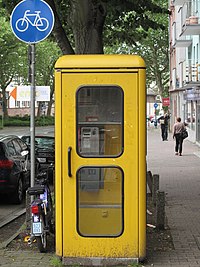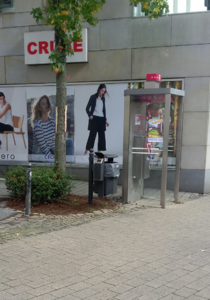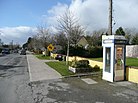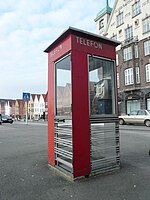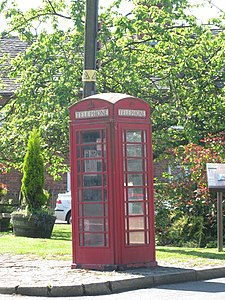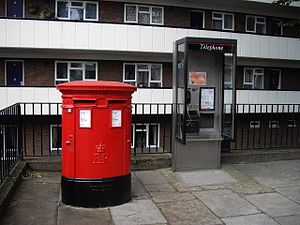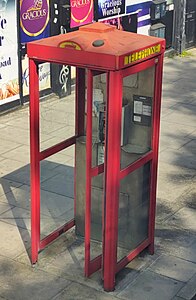Key:booth
| Description |
|---|
| The physical design of the phonebox, how it looks. |
| Group: properties |
| Used on these elements |
| Status: in use |
| Tools for this tag |
|
The design of a telephone box, how it looks.
Usage
This is a properties tag and should mostly be used in combination with telephone.
Many phone boxes have found new uses; e.g., housing defibrillators, public bookcases or tourist information.
Values in use in Germany
| Value | Description | Example picture |
|---|---|---|
| FeH_26 | Octagonal in blue or yellow with five windows per side and the writing (in gothic script) "Offentlicher Fernsprecher" at the top | |
| FeH_32 | Rectangular with seven windows per side in yellow or red, with a flared roof edging with "Fernsprecher" (in gothic script) | |
| FeH_55 | Rectangular, made of steel with just one window per side | |
| TelH_72 | ||
| TelH_78 | Rectanguar with curved in corners in yellow, two window per side (also with curved corners) | |
| TelH_90 | Originally grey and magenta with full length windows | |
| TelH_90_Sh | Eight windows per side (in four rows) with pointy roof. | |
| TelH_90_Sm | Mostly glass sided with pillar at each corner. | |
| TelH_08 | A silver cabin made of stainless steel with four windows, without any door. | |
| Telephone with support but no shelter Please do not use this value, because 'Telefonsäule' is not a booth. The correct key for describing this kind of telephone and its cover is model=*. For details, please have a look at the German page for amenity=telephone for how these German models of telephone pillars get tagged. |
Values in use in Ireland
| Value | Description | Example picture |
|---|---|---|
| K1 | Early phone box, rare, made of concrete, originally painted white and green. | |
| Telefon | Early phone box, quite rare, made of concrete, originally painted white.
There are also wooden replica Telefon boxes containing defibrillators. |
|
| Eircom | ||
| Teileafon | Modern open kiosk with internet |
Values in use in Norway
| Value | Description | Example picture |
|---|---|---|
| Riks | There are 100 preserved in Norway, some used as book swaps. |
Values in use in United Kingdom
| Value | Description | Example picture | |
|---|---|---|---|
| K1 | Early phone box, quite rare, made of concrete, originally painted white. | ||
| K2 | Large cast iron phone box, mainly only found in London, is larger than the more common K6 and has 18 portrait orientated window panes per side compared to the landscape orientated window panes found in the K6. | ||
| K3 | Cheaper concrete version of the K2, very few remaining. | ||
| K4␣Post␣Office | Combined phonebox and postbox, similar to K2 phonebox but larger and with a postbox and stamp machine on one side. There are only six left in the UK. | ||
| K6 | Most common type of red BT phone box, usually red (except in Hull where they are white/cream) or where they have been repurposed. | ||
| K8 | Phone box with just a single window pane per side produced in the 60s and 70s usually red, but white/cream in Hull. | ||
| KX100 | Aluminium and glass phone box produced in the 80s and 90s, some have doors some do not. | ||
| KX200 | Half a booth made of aluminium and glass | ||
| KX300 | A three sided version of the KX100. | ||
| KX410 | |||
| KX420 | |||
| KX520 | |||
| KXPlus | Aluminium and glass phone box produced since the 90s, very similar to the KX100 but with a domed plastic roof. | ||
| oakham | Small yellow telephone cover said to resemble Oakham meat tins | ||
| ST6 | An advertising board with a phone stuck on the back.
(ST is abbreviation for Street Talk) |
||
| InLink | Double-sided electronic freestanding advertising board with WiFi, tablet, USB ports and free public phone on the narrow side. | ||
| NWPyramid | New World payphone; three-sided box with a pyramid top. can have a phone icon on the roof edge, and WiFi. Usually black or red. | ||
| NWCapped | New World payphone; three-sided box with a pyramid top, capped with a smaller pyramid. can have a phone icon on the roof edge, and WiFi. Usually black or red. |
This tagging is used for public telephones (amenity=telephone). The tag covered=booth was chosen because the tag shelter=yes does not have the same meaning. shelter=yes on an object shows that there is an amenity=shelter at this object and this is not the same as a phone booth. A phone booth is intended to cover the person who is using the phone, but it's not a shelter where several people can wait on a bus or stay protecting them from rain comfortably.
Please note that covered=booth is the above-tag for the key booth=*, which specifies the type of booth.
For tagging a phone booth which is used as a public bookcase, please use amenity=public_bookcase + public_bookcase:type=phone_box + booth=<boothtype> instead. covered=booth is not so appropriate for these, because this tag describes how a feature is covered, not the feature itself (which would be a public bookcase then). Former phone booths which are public bookcases now are the one exception where booth=* can be added without adding covered=booth before.




